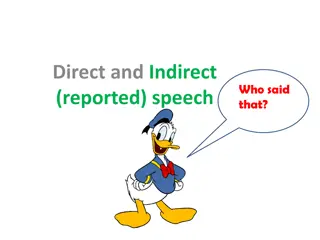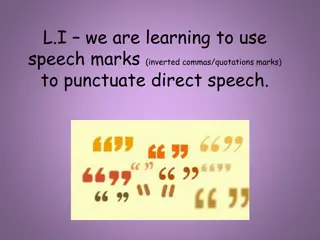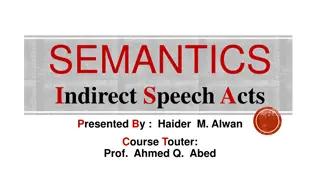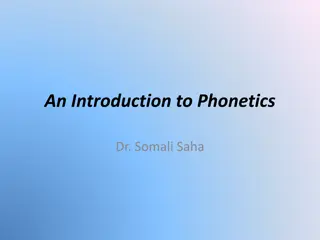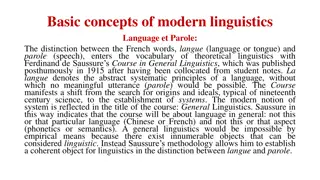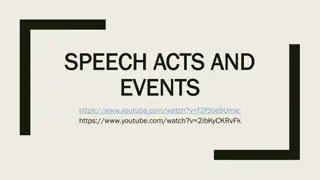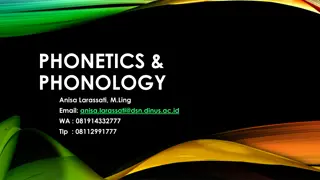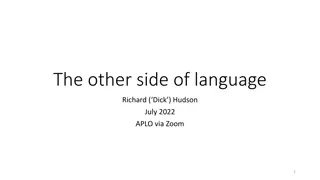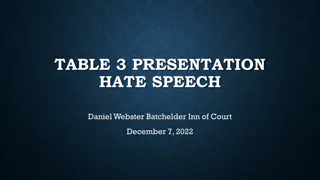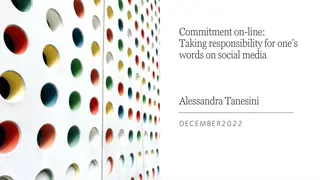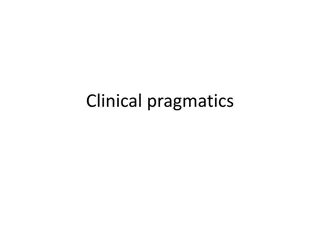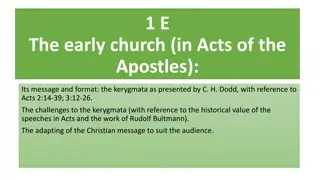Understanding Speech Acts and Politeness in Linguistics
This informative content explores the concepts of speech acts, including direct and indirect speech acts, and the role of politeness in communication. It highlights how speakers convey intentions through their utterances, distinguishing between different speech acts such as requesting, commanding, and informing. The importance of recognizing indirect speech acts to avoid miscommunication is also discussed. Additionally, the text delves into the notion of politeness in linguistics, focusing on the concept of "face" as a key factor in interactions and the implications of face-threatening acts.
Download Presentation

Please find below an Image/Link to download the presentation.
The content on the website is provided AS IS for your information and personal use only. It may not be sold, licensed, or shared on other websites without obtaining consent from the author. Download presentation by click this link. If you encounter any issues during the download, it is possible that the publisher has removed the file from their server.
E N D
Presentation Transcript
SPEECH ACTS FORM AND FUNCTION
We have been considering ways in which we interpret the meaning of an utterance in terms of what the speaker intended to convey. We have not yet considered the fact that we usually know how the speaker intends us to take (or interpret the function of ) what is said. In very general terms, we can usually recognize the type of action performed by a speaker with the utterance.We use the term speech act to describe actions such as requesting , commanding , questioning or informing .We can define a speech act as the action performed by a speaker with an utterance. If you say, I ll be there at six, you are not just speaking, you seem to be performing the speech act of promising .
Compare that utterance with Can you pass the salt? In this second example, we are not really asking a question about someone s ability. In fact, we don t normally use this structure as a question at all. We normally use it to make a request. That is, we are using a syntactic structure associated with the function of a question, but in this case with the function of a request. This is an example of an indirect speech act. Whenever one of the structures in the set above is used to perform a function other than the one listed beside it on the same line, the result is an indirect speech act.
It is possible to have strange effects if one person fails to recognize another person s indirect speech act. Consider the following scene. A visitor to a city, carrying his luggage, looking lost, stops a passer-by. : Excuse me. Do you know where the Ambassador Hotel is? - : Oh sure, I know where it is. (and walks away)
POLITENESS We can think of politeness in general terms as having to do with ideas like being tactful, modest and nice to other people. In the study of linguistic politeness, the most relevant concept is face . Your face, in pragmatics, is your public self-image. This is the emotional and social sense of self that everyone has and expects everyone else to recognize. Politeness can be defined as showing awareness of and consideration for another person s face.
If you say something that represents a threat to another persons self-image, that is called a face-threatening act. For example, if you use a direct speech act to get someone to do something (Give me that paper!), you are behaving as if you have more social power than the other person. If you don t actually have that social power (e.g. you re not a military officer or prison warden), then you are performing a face-threatening act.
An indirect speech act, in the formassociated with a question (Could you pass me that paper?), removes the assumption of social power. You re only asking if it s possible. This makes your request less threatening to the other person s face. Whenever you say something that lessens the possible threat to another s face, it can be described as a face-saving act.
Negative and Positive Face We have both a negative face and a positive face. (Note that negative doesn t mean bad here, it s simply the opposite of positive .) Negative face is the need to be independent and free from imposition. Positive face is the need to be connected, to belong, to be a member of the group. So, a face-saving act that emphasizes a person s negative face will show concern about imposition (I m sorry to bother you . . .; I know you re busy, but . . .).
A face-saving act that emphasizes a person s positive face will show solidarity and draw attention to a common goal (Let s do this together . . .; You and I have the same problem, so . . .). Ideas about the appropriate language to mark politeness differ substantially from one culture to the next. If you have grown up in a culture that has directness as a valued way of showing solidarity, and you use direct speech acts (Give me that chair!) topeoplewhose culture is more oriented to indirectness and avoiding direct imposition, then you will be considered impolite
You, in turn,may think of the others as vague and unsure of whether they really want something or are just asking about it (Are you using this chair?). In either case, it is the pragmatics that is misunderstood and, unfortunately, more will be communicated than is said. Understanding how successful communication works is actually a process of interpreting not just what speakers say, but what they intend to mean .




